Exploring Surfboard Manufacturing: Craft and Innovation
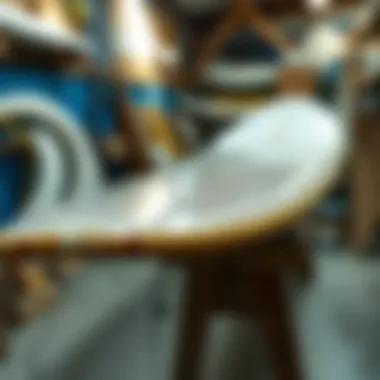
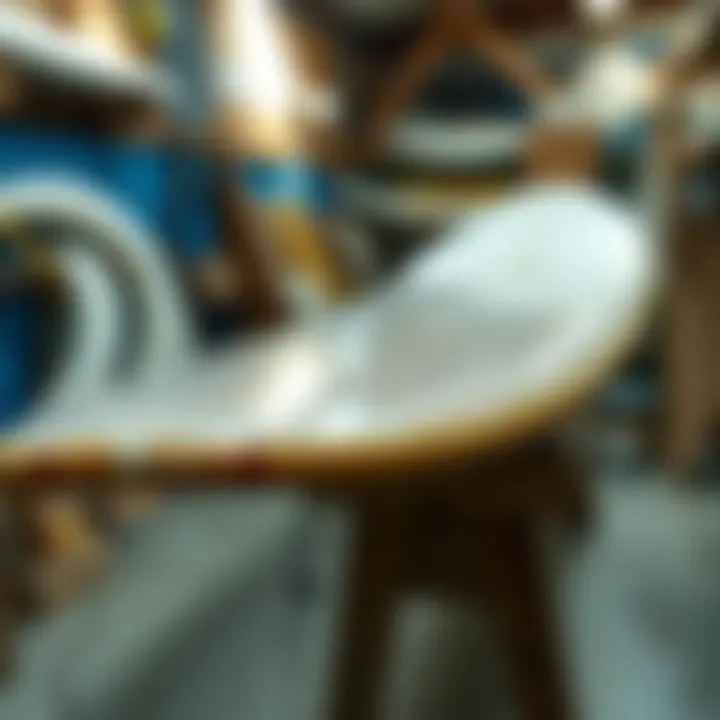
Intro
Surfing is more than just a sport; it’s a lifestyle, a culture, and for some, a personal pilgrimage towards harmony with the ocean. The magic starts long before you hit the waves, however, as it all begins with the surfboard. Most surfers probably don’t realize the incredible symphony of arts and sciences involved in surfboard manufacturing. Each board is a product of intricate design, engineering, and craftsmanship, shaped to cater to diverse surfing styles and conditions.
This article will navigate through the fascinating process of surfboard creation. From the materials chosen to the techniques employed, we will cover essential aspects that contribute to performance and longevity of the boards, all while keeping an eye on sustainability—a hot topic in today’s surfing community. With this comprehensive guide, both enthusiasts and hobbyists can uncover the layers that constitute their essential surfing companion.
Surfing Techniques
Successfully riding the waves requires not just the right gear but also a solid foundation in techniques:
Beginner Tips for Getting Started
If you're just stepping onto the surf scene, it’s important to start with the fundamentals. Here's how to get rolling:
- Understand the basics: Knowing how to paddle, pop up, and balance is critical. Spend time practicing these in smaller waves first.
- Select the appropriate board: A soft-top board is often recommended for newbies due to its stability and safety.
- Stay aware of your surroundings: Pay attention to currents, tides, and other surfers. It’s part of surfing etiquette and keeps you safe.
- Practice your timing: Catching a wave requires finesse. Timing your takeoff with the wave's movement is key.
Advanced Maneuvers and Tricks
Once you’ve got the basics down, it’s time to step up your game. Here are some advanced techniques to help surfers progress:
- Cutbacks: This maneuver involves turning back towards the breaking wave after a ride. It enhances control and is visually striking.
- Air Tricks: Executing aerial maneuvers requires a good mix of speed, skill, and courage. Start simple and gradually work your way up.
- Tube Riding: The holy grail for many is riding inside the barrel of a wave. It requires exceptional timing and commitment, often taking years to master.
"The measure of a man’s character is what he would do if he knew he would never be found out." — This quote, often attributed to Thomas B. Macaulay, can resonate in surfing. Commitment to performance can make all the difference in both surfing and surfboard design.
Surfboard Selection
Choosing the right surfboard can be daunting—it’s like finding the perfect dance partner. Here’s how you can ease that journey:
Choosing the Right Board for Your Style
When selecting a board, consider these factors:
- Your skill level: Beginners often benefit from wider, thicker boards that offer more stability, while advanced surfers may prefer shorter, more agile boards for tricks.
- Wave types: The surf conditions play a huge part in board selection. For small, mellow waves, a longboard may be ideal; for faster, steeper waves, you might consider a shortboard.
- Environmental aspects: Keep sustainability in mind. Modern manufacturers are creating boards from eco-friendly materials, which can greatly influence your selection.
Surfboard Maintenance and Care
Caring for your surfboard can extend its life significantly:
- Rinse with freshwater: Always rinse off salt and sand after a session to prevent wear and damage.
- Store properly: Avoid leaving your board in direct sunlight for long periods. A board bag can help grant it some protection.
- Regular checks: Inspect for dings and repairs. A quick fix can save you from more extensive damages later on.
Being mindful of these factors will not only help maintain your board but will also heighten your overall surfing experience.
Understanding Surfboards: Beyond the Basics
Surfboards are more than just planks ridden on waves; they are a fusion of art, science, and innovation. Understanding surfboards thoroughly not only enhances the surfing experience but also empowers enthusiasts to choose the right board tailored to their needs. Each element of a surfboard contributes significantly to its performance on the water, providing a blend of control, speed, and maneuverability.
When we talk about the importance of grasping surfboard essentials, we highlight the relationship between design choices and surf conditions. For example, a board designed for small, mellow waves will differ vastly from one made for powerful, steep swells. Grasping these differences is like knowing the difference between a hammer and a screwdriver; each tool serves a unique purpose.
The benefits of diving deep into surfboard knowledge are manifold:
- Informed Purchases: Understanding specific surfboard features aids in making educated choices, whether buying a new board or customizing an existing one.
- Enhanced Performance: Knowledge of board characteristics allows surfers to exploit their equipment's full potential, leading to better rides and maneuvers.
- Sustainability Awareness: As the industry shifts towards eco-friendly materials, understanding surfboards helps advocate for sustainable practices that can lead to positive environmental impacts.
This section sets the tone for an exploration into surfboard technology. We will unravel the evolution of surfboards and delve into key components that make up these dynamic ocean dwellers.
The Evolution of Surfboard Design
The history of surfboard design is a testament to human creativity and adaptation. Initially fashioned from solid wood, early surfboards were hefty and cumbersome, making the art of surfing a challenge. Over the decades, materials and techniques evolved remarkably. From the introduction of foam constructions in the late 20th century to modern advances like carbon fiber and eco-resins, the surfboard has transformed, reflecting both technological advancements and shifts in surfing culture. This evolution indicates how dependent and adaptive surfboards have become to the needs of surfers worldwide.
Key Components of a Surfboard
Surfboards are engineered through specialized components, each affecting performance and user experience significantly. Understanding these elements is crucial for anyone involved in the surf world.
Stringers
Stringers are essential structural components that run the length of a surfboard, serving as the backbone. Made typically from wood, they provide rigidity while allowing some flex. The presence of stringers enhances durability and helps maintain the board's shape over time, which is a significant characteristic. Their flexibility offers a unique feel while riding, as they absorb impact and facilitate dynamic movements.
However, a heavier stringer can weight down a board, which might be a drawback for lightweight performance in competitive surfing.
Fins
Fins are pivotal in fine-tuning a surfboard's handling and responsiveness. Acting like rudders, they provide stability while enabling the surfer to steer and control the board. Different fin setups—like thrusters, quads, or single fins—cater to varying styles of riding. The key quality of fins is their ability to enhance grip on the waves, crucial for executing sharp turns and maneuvers.
On the downside, too many fins can lead to drag, which can be detrimental in certain conditions.
Tail Shapes
Tail shapes vary significantly and influence a board's capabilities. Options like squash, round, and pin tails each offer unique handling properties. For example, a pin tail is popular in big wave surfing due to its ability to slice through water effortlessly and maintain speed. Conversely, a wider tail like the squash is often favored for gaining maneuverability in smaller waves. This diversity allows surfers to tailor their boards based on personal preferences and specific wave types.
However, selecting a tail shape that doesn't match the wave conditions can hinder performance.
Rail Profiles
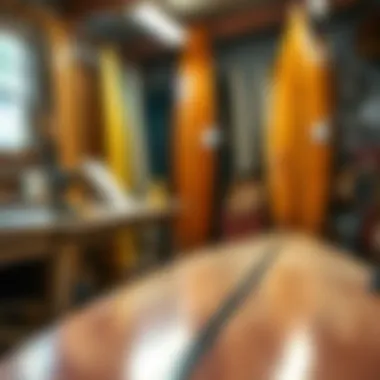
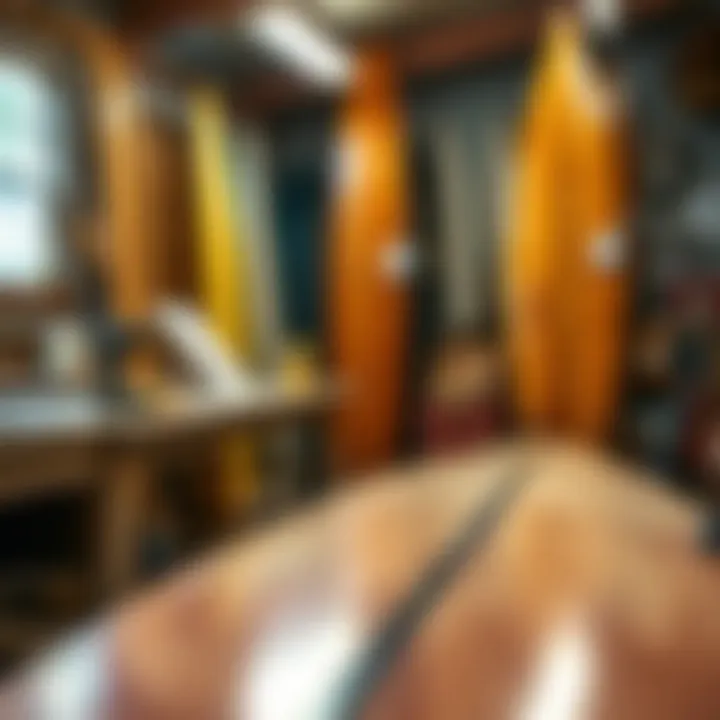
Rail profiles refer to the edges of the surfboard, influencing how the board interacts with water. Thinner rails typically provide better, sharper turns, which is beneficial for advanced maneuvers. Thicker rails, on the other hand, offer more buoyancy, making them ideal for beginners still learning to balance. Each profile's unique feature holds importance in the board’s performance, and the right choice often hinges on the surfer's skill level and wave conditions.
However, an improper rail profile can lead to instability in choppy waters, making it harder for surfers to maintain control.
Understanding these key components enhances our ability to make informed decisions regarding our surfboards.
Overall, grasping the intricacies of these elements not only enriches the surfing experience but also fosters a deeper appreciation for the craft behind surfboard manufacturing.
Materials Used in Surfboard Construction
The materials utilized in surfboard construction play a pivotal role in determining the performance, durability, and environmental impact of the final product. With surfing becoming increasingly popular, it has become essential for both manufacturers and surfers to understand how the choice of materials influences everything from buoyancy to resistance against the elements. This section delves into traditional materials and emerging eco-friendly options, highlighting their respective advantages and considerations.
Traditional Materials: Foam and Fiberglass
One cannot discuss surfboards without acknowledging the classic combination of foam and fiberglass. These materials have stood the test of time due to their effectiveness, making them a cornerstone of surfboard manufacturing. The core of most surfboards is made up of polyurethane or expanded polystyrene foam, which is lightweight yet provides the necessary buoyancy. This soft foam is then covered with fiberglass cloth that is saturated with resin, creating a strong and rigid shell.
Using fiberglass adds not only strength but also allows for a smooth finish, which enhances the board's aerodynamics when slicing through water. While this tried-and-true method is still prevalent, there are downsides—like the production waste generated and issues regarding biodegradability—which have led manufacturers to explore alternatives.
Emerging Materials: Eco-friendly Alternatives
As the surfing world becomes more aware of its environmental footprint, innovative materials are emerging to replace traditional options, reducing waste and promoting sustainability.
Bamboo
Bamboo has carved a niche for itself in the surfboard manufacturing domain. Known for its rapid growth and renewable properties, bamboo is hailed as a sustainable alternative. Its lightweight nature contributes to overall board performance, allowing for enhanced maneuverability on waves.
One unique feature of bamboo is its natural strength; it's comparable to many hardwoods, providing a solid structure without excess weight. However, while it has several advantages, the flexibility of bamboo can pose challenges when used in certain surfboard designs. Overall, its ability to provide environmental benefits while not sacrificing too much performance makes it an attractive choice in contemporary surfboard making.
Recycled Foam
Recycled foam has emerged as a fantastic alternative to conventional foam materials. Utilizing off-cuts and scraps from regular foam production, it provides a similar buoyancy and durability at a lower environmental cost.
Beneath its surface, recycled foam maintains the performance characteristics necessary for effective surfing. However, while this material excels in reducing waste, its consistency can sometimes be a problem. If not sourced well, recycled foam might lack uniform quality, which could affect the overall surf experience. For environmentally conscious surfers, though, using recycled materials aligns with a sustainability ethos while still allowing for high performance.
Biodegradable Resins
Biodegradable resins are an innovative step forward for eco-conscious surfboard manufacturers. This material can decompose naturally, addressing one of the major concerns with traditional epoxy or polyester resins which last indefinitely in landfills.
Biodegradable resins not only reduce the environmental impact but also maintain good bonding capabilities, ensuring the structural integrity of the board. An important consideration here is the curing process, which might take longer compared to conventional resins, possibly affecting production timelines. Nevertheless, the shift towards biodegradable options reflects the industry’s commitment to embracing sustainability while also catering to the performance needs of modern surfers.
The Craftsmanship Behind Surfboard Shaping
In the world of surfboards, craftsmanship plays a pivotal role that combines artistry and technical expertise. It’s not merely about slapping some materials together; it’s about creating a piece of equipment that allows surfers to dance with the ocean. This section digs into various tools and shaping techniques, showcasing their significance in producing surfboards that not only look good but perform exceptionally well.
Tools of the Trade
Every surfboard shaper has a specific arsenal of tools that they rely on to mold foam into a finely-tuned watercraft. Each tool has its unique function and contributes towards achieving the desired shape and finish.
Planers
Planers are essential in the shaping process. These devices slice through foam with precision and control, helping to achieve the desired contours. What makes planers stand out is their ability to create a smooth and even finish that prepares the surfboard for its upcoming layers.
The key characteristic of planers is their depth adjustment feature, allowing shapers to control how much material they remove with each pass. This beneficial choice is particularly important for fine-tuning the board's outline and rocker. One noteworthy feature of modern electric planers is their ability to operate without excessive noise, creating a more comfortable working environment.
However, they can be quite aggressive, so one must handle them with care to avoid taking off too much foam too quickly. Precision is key in this balancing act between artistry and function.
Sanding Machines
When it comes to achieving that finished look, sanding machines are invaluable. They help create a smooth surface, ready for the final coat of resin. The key characteristic of sanding machines is their versatility, allowing for different grits to be applied based on the level of finish desired. For final touches, finer grits can be used, creating a glossy surface that not only looks appealing but also has a practical aspect—reducing drag in the water.
What makes sanding machines a popular choice in the industry is their efficiency. They allow shapers to remove imperfections swiftly. One drawback, however, is that they can be tricky to master. Over-sanding can ruin the board’s shape or weaken it, creating a potential danger in the water. Balancing speed with caution is critical during this step in the process.
Templates
The use of templates is another layer in the intricate craft of surfboard shaping. These are pre-cut patterns that guide shapers in achieving specific board designs. A key characteristic of templates is their replicability; once a template is created, it can be used time and again for consistent results. This consistency is vital for brands focusing on producing similar boards to meet customer demands.
Templates provide a beneficial approach to ensure the dimensions are precise, promoting balance and performance in the final product. The unique feature of templates is their ability to save time, as shapers don’t have to start from scratch every time. However, they can limit creativity. Relying too heavily on them might discourage a shaper from exploring custom shapes or innovations.
Shaping Techniques: An Overview
Shaping techniques vary widely, and each comes with its advantages and disadvantages. Understanding these methodologies is crucial for anyone interested in the intricacies of surfboard making.
Hand Shaping
Hand shaping represents the traditional method of crafting surfboards. In this hands-on approach, shapers can intricately manipulate the foam using various tools. The key characteristic of hand shaping is the tactile feedback it offers. Shapers can feel the material as they work through it. This method promotes creativity, as each board can be customized based on the shaper's instincts.
What makes hand shaping a beneficial choice is its ability to produce unique boards that reflect a shaper’s personal style. However, the downside is the time investment. Hand shaping usually takes much longer than machine-based methods, which might not be practical for larger production runs.
Machine Shaping
Despite the classic appeal of hand shaping, machine shaping has gained traction in recent years. This method utilizes automated equipment to create boards with high precision and speed. A key characteristic of machine shaping is its repeatability, producing uniform boards consistently.
Its beneficial nature lies in efficiency; it allows surfboard manufacturers to meet high demand without sacrificing quality. However, a possible disadvantage is the loss of personal touch—a machine might produce a perfect outline, but it may lack the character that comes from manual shaping.
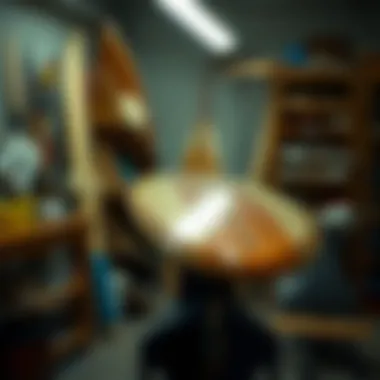

Hybrid Approaches
Bridging the gap between hand and machine shaping, hybrid approaches have started to emerge. This technique combines the best of both worlds, allowing shapers to use machines for the rough shape and then finish the detailing by hand. The key characteristic of hybrid shaping is its flexibility. Shapers can work faster while still infusing personal flair into their boards.
The advantage of this approach is the potential for high-quality results in less time. Still, it requires knowledge in both machine operation and hand crafting, which may pose a learning curve for novice shapers.
"The craft of surfboard shaping is as much about the journey as it is the destination. Each board embodies the shaper's vision and connection with the ocean."
Finishing Touches: The Surfboard Coating Process
The coating process in surfboard manufacturing is often the unsung hero of the craft. Without the right finish, all the careful shaping and meticulous design can go to waste. It's not just about aesthetics; the coating protects the board and enhances its performance on the waves. A well-coated surfboard can withstand the rigors of saltwater, sun exposure, and physical impacts, ultimately prolonging its life and usability.
In this section, we’ll delve into two primary types of resins used in surfboard finishing: epoxy and polyester resins. Both materials have their own set of characteristics, advantages, and disadvantages that impact the overall performance of the board and the preferences of the surfer.
Epoxy vs Polyester Resins
When it comes to surfboard coatings, epoxy and polyester resins stand out as the most common choices. Epoxy resins are generally known for their superior strength and flexibility, making them ideal for high-performance boards. They cure faster than polyester resins and often allow for thinner layers of coating, which can help minimize weight without sacrificing durability. Additionally, epoxy resins are less harmful to the environment, as they emit fewer volatile organic compounds (VOCs) during production.
On the flip side, polyester resins have been a favorite among manufacturers for decades due to their ease of use and lower cost. They offer a glossy finish that many surfers find appealing. However, polyester-coated boards do have a tendency to yellow over time and can be less resilient to impacts compared to their epoxy counterparts. Thus, the choice between the two often boils down to personal preference and intended use.
Art and Aesthetics: Custom Deck Designs
Customization has become a defining feature in the surfboard industry. From the patterns etched into the wax to the vibrant designs painted on the deck, artists have taken surfboard aesthetics to another level. This section will explore how unique designs can contribute to both personal expression and brand identity in the surf culture.
Airbrushing Techniques
Airbrushing is a popular method for customizing surfboards. This technique allows for intricate designs and smooth gradients, which can create visually stunning effects. One of the key characteristics of airbrushing is its ability to cover large areas quickly, while still providing detailed artistry. Airbrush artists often have a keen eye for color theory, which enables them to create harmonious and compelling designs in a variety of palettes.
But there’s more to airbrushing than just looks. The finish provided by this technique can also add a layer of protection to the underlying resin, enhancing the durability of the board. However, airbrushing requires skilled hands — if mishandled, it can result in runs, drips, or unevenness that might detract from the final product’s appeal.
Graphics and Prints
Another approach to surfboard design involves the use of graphics and prints. These designs can range from simple logos to complex illustrations that cover the entire board. The key characteristic here is versatility; designs can be tailor-fitted to reflect a surfer’s style or represent a brand's ethos.
Unlike airbrushing, graphics are often applied through screen printing or digital printing techniques which can maintain sharp lines and vivid colors without the risk of smudging or fading that sometimes accompanies paint methods. This method is particularly advantageous for surfboard manufacturers looking to produce multiple units with consistent branding.
"The true essence of a surfboard transcends its function; it embodies the spirit of the waves and the soul of the rider."
For more insights into surfboard design and customization, consider exploring resources like Wikipedia, Britannica, or discussions on platforms like Reddit.
Testing and Quality Control in Surfboard Production
When it comes to crafting surfboards, the journey doesn't end once the shaping process is over. Testing and quality control play crucial roles in ensuring that each board meets the high standards expected by surfers. Surfers require boards that not only perform well but also withstand the rigors of the ocean. Quality control, thus, serves to verify that these benchmarks are consistently met, safeguarding the integrity of the final product.
Performance Metrics
In the realm of surfboard production, performance metrics are essential indicators of how well a board will perform in real-world conditions. These metrics encompass various aspects such as flexibility, wave responsiveness, and durability.
Flexibility
Flexibility is a fundamental attribute that determines how a surfboard interacts with the waves. A flexible board is responsive and can adapt to the energy of the surf, allowing the rider to execute maneuvers more easily. The key characteristic of flexibility lies in its balance — too much can lead to instability, while too little may make a board rigid and unresponsive.
One of the advantages of a flexible surfboard is the improved ability to absorb shock when landing from jumps or navigating choppy waters. However, this flexibility comes with a trade-off; boards that are too flexible may not perform as well in bigger, heavy waves, as they lack the needed rigidity for stability.
Wave Responsiveness
Wave responsiveness refers to how quickly and accurately a surfboard reacts to the contours and movements of the water. A highly responsive board is often preferred by surfers looking to make quick turns and adaptations as they ride. The surfboard's design, including its rocker and fin configuration, directly influences this responsiveness.
The unique feature of wave responsiveness is its ability to turn intentions into action almost instantaneously. Riders can exploit this characteristic to navigate tricky waves effectively. However, boards designed solely for high responsiveness might sacrifice stability, which could pose difficulties for novice surfers.
Durability Tests
Durability tests are integral to the production process, focusing on the longevity of the surfboard under various conditions. These tests evaluate how well a board withstands impacts, water exposure, and even UV damage from prolonged sunlight. The main characteristic of durability lies within the material choices and construction techniques employed.
A durable surfboard promises longevity, reducing the frequency and cost of replacements. However, achieving high durability often means the board may be heavier or less flexible, which could affect performance. Striking the right balance between durability and other performance metrics is vital, and requires careful consideration during the manufacturing process.
User Feedback: The Role of Experienced Surfers
Experienced surfers play an invaluable role in the testing and quality control phase. Their insights and feedback provide manufacturers with practical evaluations that metrics alone cannot offer. Surfers often have particular preferences when it comes to board performance, and amateur testing with actual riders helps create a more refined product.
The importance of incorporating user feedback cannot be overstated. It adds a layer of credibility and authentic experience to the validation process. Surfboard makers frequently invite seasoned surfers to test new designs, engaging them in discussions about what works and what doesn’t in varied conditions.
In summary, effective testing and quality control in surfboard production is not just about metrics and material properties. It creates a fusion of scientific rigor and user experience, ensuring that surfers receive boards tailored to their needs and capable of performing in challenging environments.
Sustainability in Surfboard Manufacturing
Surfboard manufacturing isn't just about performance and style anymore; it’s increasingly about being good stewards of the environment. The importance of sustainability in surfboard production has come to the forefront of discussions among surfers, manufacturers, and environmental advocates. As the waves crash and the tides change, so too must the practices in how surfboards are made. The benefits of adopting sustainable practices are manifold, affecting not just the health of our oceans but also enhancing the surfing experience itself.
When considering sustainability, it’s crucial to address the environmental responsibility that comes with producing these boards. Many traditional materials used in surfboard manufacturing, such as polyurethane foam and fiberglass, can have long-lasting negative impacts on the environment. These materials can contribute to pollution and waste, leaving a damaging footprint that appears unyielding alongside the ocean's waves. Therefore, making a conscious effort to shift toward materials and processes that lessen environmental impact is imperative.
The Importance of Environmental Responsibility
Environmental awareness in surfboard manufacturing areas comes down to the need for manufacturers to recognize their impact. In simple terms, we all share the planet, and it’s our duty to protect it. Here are some critical facets of environmental responsibility in surfboard making:


- Minimizing Waste: Every aspect of the surfboard creation process, from crafting to finishing, produces waste. Manufacturers need to analyze each step to find where they can reduce excess material and repurpose leftover parts.
- Choosing Sustainable Materials: The rise of eco-friendly alternatives such as recycled foam and biodegradable resins offers surfboard makers an avenue to reduce their environmental footprint. Selecting materials that do not harm the ocean further strengthens the case for responsibility.
- Educating Consumers: By informing surfers about how their boards are made and the environmental impact, they can make more informed purchase decisions. People tend to care more about the products they use when they understand the implications.
Ultimately, embracing sustainability becomes an integral part of the surfboard lifestyle. Surfers often feel a deep connection to the ocean, so protecting it ensures that future generations can enjoy the same waves that we cherish today.
Innovative Practices Reducing Waste
While many surfboard manufacturers are waking up to the call for sustainability, there are bright spots where innovative practices are already in place. The concept goes beyond just using sustainable materials. It's about reinventing manufacturing practices and being mindful of the overall impact. Here are some notable practices that are gaining traction:
- Recycling Programs: Some companies have pioneered programs that take back old surfboards and recycle them into new products. This not only keeps old boards out of landfills but also promotes a culture of reuse within the surfing community.
- 3D Printing Technologies: This emerging technology allows for precise, waste-minimized manufacturing. By utilizing 3D printing, manufacturers can create board components with lower excess material and more efficient designs tailored to unique surfing needs.
- Renewable Energy Use: Integrating solar or wind power in the production process is yet another way to cut down on carbon emissions. Companies are beginning to install renewable energy sources, marking a step toward greener manufacturing practices.
"Sustainable surfboarding is about creating a harmonious relationship between the craft and the ocean. The waves call for it, and we're starting to answer."
By embracing these innovative practices, the surfboard manufacturing industry can not only reduce its waste but also inspire a wave of change. The future of surfing—enjoyed by surfers today and for generations to come—depends on making responsible choices now. The push for sustainability is more than just a trend; it's a movement toward protecting the waves we love.
Customization: Tailoring Surfboards to Suit Individual Needs
Customization of surfboards is paramount in ensuring that each rider’s needs and personal preferences are met. Just like a fine suit, a surfboard designed with an individual’s specifications can enhance performance and riding enjoyment. Many surfers find that off-the-shelf models lack the finesse needed for their unique styles, leading to the growing trend of tailored surfboards. Customization encompasses various elements, from dimensions to graphics, enabling surfers to express their individuality and maximize their performance.
The Role of Dimensions in Surfboard Performance
Length
The length of a surfboard profoundly influences its maneuverability and overall performance in the water. Generally, longer boards provide improved stability, making them an excellent choice for beginners or surfers who prefer long rides. For instance, a 9-foot longboard allows for more paddling power and retains speed in smaller waves. However, it may lack the agile response that a shorter board can offer, potentially limiting sudden turns and sharp maneuvers. Therefore, while longer boards are popular for a smooth ride, they are not universally beneficial for all styles.
Width
Width plays a critical role as well, affecting buoyancy and stability. Wider boards offer increased surface area, which can equate to greater stability in the water. This quality is particularly favorable for surfers who might find balance challenging, especially in paddle-outs or when attempting to ride bigger waves. Conversely, a narrower board typically allows for sharper turns and quicker transitions, which can be advantageous for advanced techniques. The choice of width thus hinges on the rider's skill level and riding style, demanding careful consideration when customizing.
Thickness
Thickness significantly impacts the buoyancy and responsiveness of a surfboard. Thicker boards provide greater volume, leading to enhanced floatation, making them appealing for heavier surfers or those looking to ride in smaller, slower waves. Yet, they can be heavier and less responsive in high-performance surfing situations. On the flip side, a thinner board may allow for better speed and maneuverability in heavier waves, which is often favored by experienced surfers. Each thickness option invites dialogue on performance, driving the surfer to think about the ideal balance for their unique surfing conditions.
Personalized Graphics and Designs
In addition to functional aspects, visual customization is where a surfer can truly express their personality. Personalized graphics and innovative designs allow surfers to make a statement as they carve waves. From intricate airbrushing to digital prints, the sky's the limit. Surfers often choose designs that resonate with their lifestyle or heritage, which transforms a simple piece of equipment into a canvas of self-expression.
Surfers can also collaborate with local artists or even create designs themselves, adding to the artistry in the surf culture. This connection strengthens their relationship with the board and enhances the overall experience of surfing.
Customization is not simply about performance; it is about crafting an experience that reflects individuality and passion.
The Future of Surfboard Technologies
As we look ahead into the horizon of surfboard manufacturing, the infusion of cutting-edge technologies presents an exciting crossroads where tradition meets innovation. This intersection is vital not only for enhancing surfboard performance but also for making strides toward sustainability in an industry that has historically relied on materials with a hefty ecological footprint. Understanding how technology reshapes surfboards allows enthusiasts and manufacturers alike to adapt and thrive in an evolving marketplace.
Technological Innovations Impacting Design
Smart Surfboards
Smart surfboards represent a significant leap forward in the integration of technology within surfboard design. This contemporary marvel goes beyond conventional shapes and sizes; they incorporate sensors that monitor performance metrics such as speed, wave height, and rider dynamics. A key characteristic is the built-in connectivity that enables surfers to analyze their performance data via smartphone apps. This provides real-time feedback, allowing them to fine-tune their techniques and engage more deeply with their sport.
One unique feature of smart surfboards is the ability to gather data on wave conditions, providing insights for not just individual usage but also contributing to larger community data for surf forecasting. Although they come with advantages like improved performance tracking, there may be drawbacks, such as higher costs and potential concerns over battery longevity and durability in harsh ocean environments. Yet, the benefits of better performance understanding make them an intriguing option for serious surfers.
3D Printing Applications
The rise of 3D printing technology has brought a revolution to surfboard and component manufacturing. It enables the rapid prototyping of designs, allowing shapers to experiment with unique geometries without the traditional lengthy processes involved in board crafting. A prominent benefit of 3D printing is the precise customization it offers. Surfers can now order boards tailored to their specifications, which has never been this accessible before.
However, one must consider the limitation in materials. While it’s evolving, the types of 3D printable materials that can replicate the performance characteristics of traditional fibreglass or epoxy are still being developed. There’s also the challenge of durability over time, which some existing methods handle differently. Nonetheless, it’s hard to ignore the potential of 3D printing as it continues to evolve, making it a popular consideration in modern surfboard production.
Predicting Trends in the Surfboard Market
The surfboard market is heading toward a realm where sustainability and technology will define new norms. As surfers become increasingly aware of their environmental impact, manufacturers are likely to see a demand for eco-friendly boards that utilize both innovative materials and processes. Coral reefs and natural ecosystems can greatly benefit from responsible production practices.
- Key Trends to Watch:
- Growth in the use of biodegradable materials.
- Increased popularity of used and refurbished boards.
- Collaborative initiatives between brands focusing on environmental responsibility.
These shifts highlight a broader commitment within the surfing community towards sustainable practices while still enjoying the excitement of cutting-edge technology. The journey of surfboard innovation is ongoing, merging high performance with an ecological conscience, shaping the future of the sport.
The combination of technology and sustainability is where the surfboard industry is headed, uniting performance with responsibility.
Ending: Embracing the Craft of Surfboard Making
As we near the end of this exploration into surfboard manufacturing, it’s essential to recognize the esteemed craft that combines both knowledge and artistry. Surfboards are not mere boards; they are gateways to the ocean’s embrace and vehicles that hold stories of adventure, passion, and connection. This conclusion seeks to highlight the importance of embracing the intricacies of surfboard making, encapsulating both tradition and innovation that define the craft.
The Intersection of Tradition and Innovation
Within the realm of surfboard manufacturing, tradition meets innovation in a unique synergy. Traditional shaping techniques, passed down through generations, uphold a reverence for the craft. Such practices, like hand shaping with simple tools, not only foster intimacy but also create boards imbued with the shaping artisan's characteristics.
At the same time, incorporating modern innovations, including eco-friendly materials and advanced technologies, ensures the craft evolves and adapts. The infusion of smart technologies, seen in designs that monitor performance metrics or 3D printing capabilities, propels the industry forward. Here, the focus lies not solely on aesthetics or performance but on sustainability, which resonates with today’s environmentally conscious surfer.
"Craftsmanship is about survival and sustainability—echoed in every wave ridden and every board made."
Looking Ahead in Surfboard Craftsmanship
The future of surfboard craftsmanship is an intriguing prospect filled with possibilities. As surfing becomes more mainstream, the demand for personalized boards is likely to rise. Customization will play a pivotal role, allowing surfers to have equipment uniquely tailored to their physical dimensions and riding styles. Furthermore, advancements in materials science promise to reduce the weight and enhance the durability of surfboards.
As we gaze into the horizon of surfboard design and manufacturing, one can anticipate a balance between retaining the essence of what makes a surfboard special while integrating groundbreaking methodologies. The ongoing dialogue between surfers and shapers remains vital. Feedback loops will drive the evolution of designs, ensuring that the craftsmanship resonates with those who ride the waves.
For anyone engaged in this world—be it manufacturers, surfers, or enthusiasts—the journey of surfboard craftsmanship not only enriches personal experiences but also builds a future where tradition and modernity continue to surf alongside each other.



